Welcome to the vibrant world of blue birds in Indiana! This comprehensive guide, complete with a free photo booklet, is your passport to the fascinating avian life of the Hoosier State. From the rolling hills, dense forests, fertile farmland, and numerous lakes and rivers, Indiana is home to a spectacular array of birds with dazzling blue-colored birds.
Whether you are an avid birdwatcher, a nature enthusiast, or a curious beginner, this guide is designed to help you identify, appreciate, and conserve these breathtaking species. Let’s embark on this exciting journey together and delve into the captivating world of Indiana’s bluebirds!
Blue Birds Found In Indiana
The diverse geography of Indiana provides an ideal habitat for a wide variety of bird species, including those with blue-colored birds. The state’s dense forests offer plenty of nesting and feeding opportunities, while the numerous water bodies attract a variety of waterfowl and wading birds.
Indiana lies within major migratory range maps for many bird species, contributing to the state’s avian diversity.
Eastern Bluebird
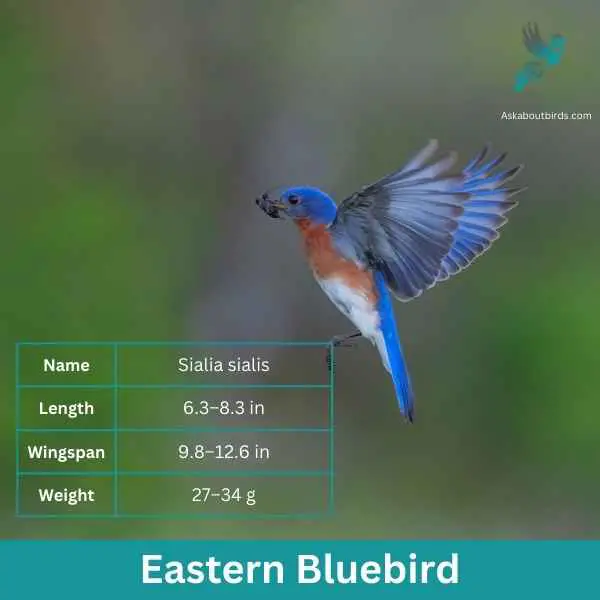
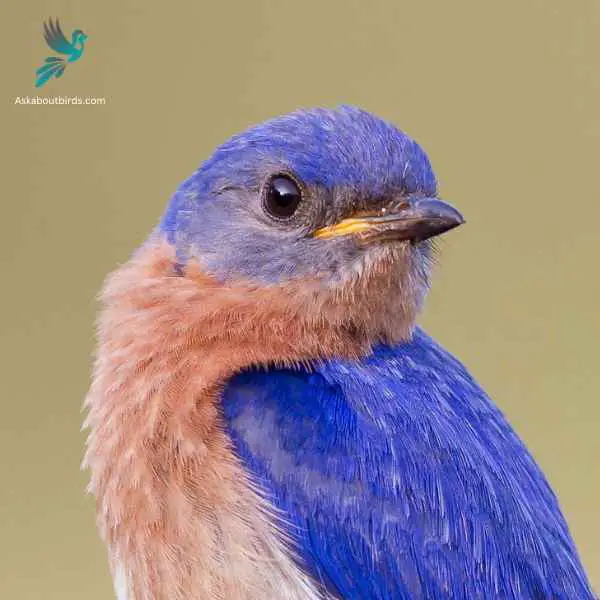
| Feature | Measurement |
|---|---|
| Scientific Name | Sialia sialis |
| Length | 6.3–8.3 in |
| Wingspan | 9.8–12.6 in |
| Weight | 27–34 g |
The Eastern Bluebird (Sialia sialis) is a small thrush found in open woodlands, farmlands, and orchards, and is recognized for its vibrant blue and red coloration. Male Eastern Bluebirds are dazzling with bright blue upperparts and a rusty or brick-red throat and breast, while females, though less colorful, still offer a similar pattern. The bird is native to North America and is commonly seen east of the Rockies, from Canada to the Gulf States and southeastern Arizona to Nicaragua.
Eastern Bluebirds feed on insects, wild fruit and berries. They have a gentle nature and are often seen perched alone or in small groups in the open, scanning the ground for prey. They are cavity nesters and will use old woodpecker holes or birdhouses if they are the right size.
Blue Grosbeak
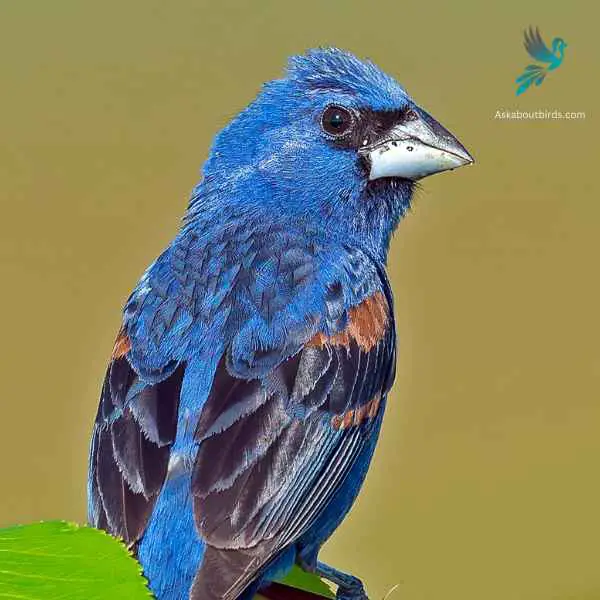

| Feature | Measurement |
|---|---|
| Scientific Name | Passerina caerulea |
| Length | 5.5 to 7.5 in |
| Wingspan | 10 to 11 in |
| Weight | 26 to 31.5 g |
The Blue Grosbeak is a medium-sized songbird found in North and Central America. The male Blue Grosbeak displays stunning plumage with deep blue feathers on its body and head, while the female has more subdued brownish tones. Both sexes have a thick, conical bill, which gives them their name “grosbeak,” meaning large beak.
These birds prefer open habitats such as grasslands, brushy areas, and woodland edges. Blue Grosbeaks are known for their melodious songs, which consist of a series of rich and varied notes. They primarily feed on seeds and insects, using their strong beaks to crack open seeds and forage on the ground or in low vegetation.
Blue-gray Gnatcatcher
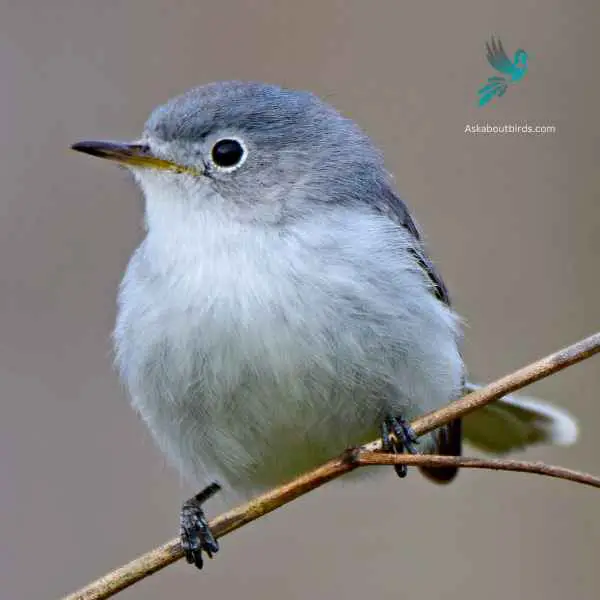
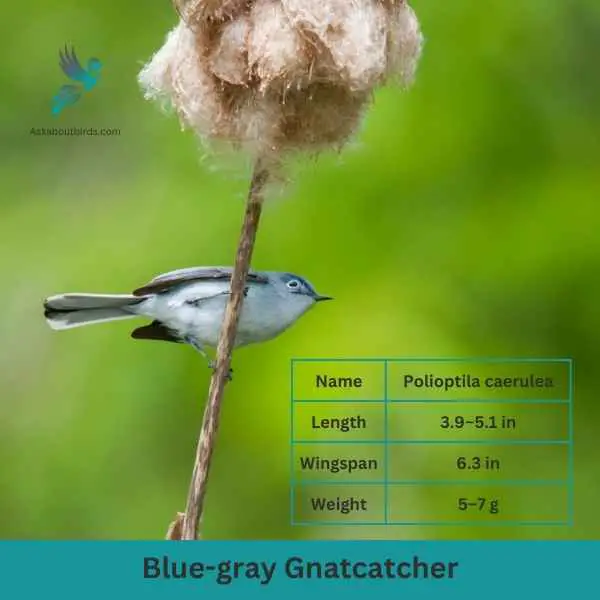
| Feature | Measurement |
|---|---|
| Scientific Name | Polioptila caerulea |
| Length | 3.9–5.1 in |
| Wingspan | 6.3 in |
| Weight | 5–7 g |
The Blue-gray Gnatcatcher is a petite, active bird, frequently observed flitting about treetops, emitting its distinctive high-pitched calls as it moves agilely through the branches.
Appearance: This bird exhibits a predominantly blue-gray plumage with a subtle white eye ring and long, slender tail feathers. The tail has distinctive black and white edging, with the males sometimes showing a faint black line on their forehead during the breeding season.
Diet: Blue-gray Gnatcatchers primarily feed on small insects and spiders. They’re adept hunters, foraging actively among foliage and even catching insects in mid-air.
Reproduction: These birds weave compact, cup-shaped nests on tree branches using plant materials, spider webs, and lichen. The exterior of the nest often matches the tree bark, making it well camouflaged. Inside, the female lays a clutch of 3 to 5 blue or greenish eggs, which she incubates.
Indigo Bunting


| Feature | Measurement |
|---|---|
| Scientific Name | Passerina cyanea |
| Length | 4.5–5.1 in |
| Wingspan | 7.1–9.1 in |
| Weight | 11.2–21.4 g |
The Indigo Bunting is a strikingly vibrant songbird, often hailed for its brilliant blue plumage and melodic song that graces woodlands and meadows during the warmer months.
Appearance: Males are renowned for their bright indigo blue feathers, which can appear darker in certain lights. Females and juveniles, on the other hand, are brown with subtle hints of blue on their wings and tail. The species lacks the vibrant streaking or spotting commonly found in many other songbirds.
Diet: Indigo Buntings primarily subsist on seeds, especially during non-breeding seasons. During the breeding season, they also consume a variety of insects such as beetles, caterpillars, and spiders, providing essential protein for their growing chicks.
Reproduction: Indigo Buntings build their nests close to the ground in shrubs or low tree branches. These nests, crafted meticulously with grasses and other plant materials, cradle clutches of typically 3 to 4 eggs. After hatching, the young are fed by both parents until they’re ready to fledge.
Common Grackle
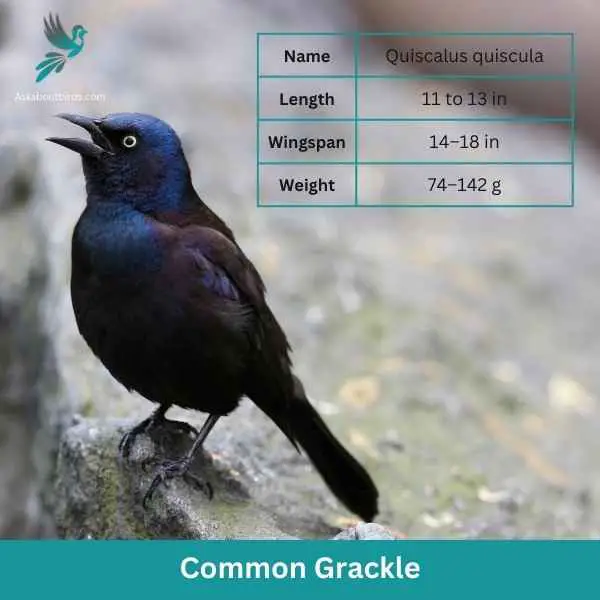

| Feature | Measurement |
|---|---|
| Scientific Name | Quiscalus quiscula |
| Length | 11 to 13 in |
| Wingspan | 14–18 in |
| Weight | 74–142 g |
The Common Grackle is a conspicuous bird found across much of North America, recognized for its glossy-black plumage, long tail, and piercing yellow eyes. Its vocalizations are varied and include a range of harsh, grating calls.
Appearance: The Common Grackle has a sleek black body with a glossy-iridescent sheen that can appear purple, green, or blue in certain lights. Its tail is long and keel-shaped. While both males and females have similar coloration, males are noticeably larger and shinier than females.
Diet: Common Grackles are omnivores. They primarily consume seeds, berries, and insects. However, they are also known to eat small fish, amphibians, and other birds’ eggs, especially when foraging on the ground or in shallow water.
Reproduction: Common Grackles breed in open and semi-open areas. The female typically selects the nest site and constructs a bulky nest made of grasses, twigs, and other plant materials, often in shrubs or trees. She lays a clutch of about 1 to 7 eggs, which are pale blue and spotted with brown.
Blue Jay

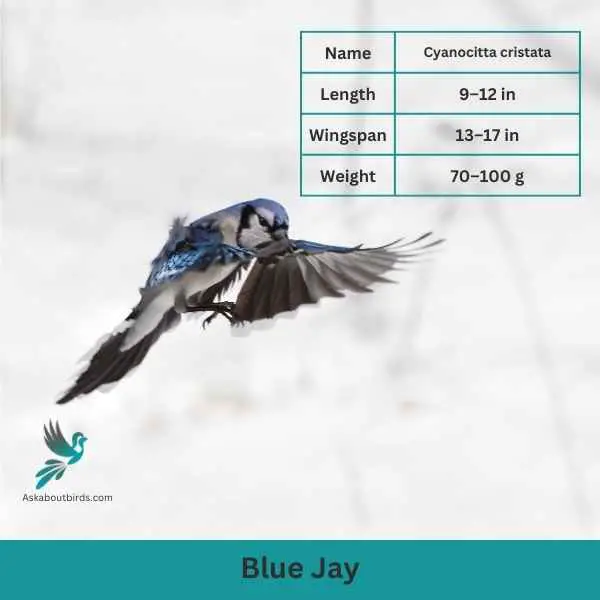
| Feature | Measurement |
|---|---|
| Scientific Name | Cyanocitta cristata |
| Length | 9–12 in |
| Wingspan | 13–17 in |
| Weight | 70–100 g |
The Blue Jay is a vibrant and easily recognized bird, known for its intelligence, distinctive calls, and bold behavior, commonly found throughout the eastern and central United States.
Appearance: The Blue Jay sports a striking blue upper body with white and black markings. Its face has a pronounced white patch with a black necklace that runs across the throat and around the head. The bird also features a pronounced blue crest, which can be raised or lowered, and its wings and tail are brightly colored with black bars and white tips.
Diet: Blue Jays are omnivores. Their diet consists primarily of seeds, nuts, especially acorns, fruits, and small insects. They’ve also been known to eat eggs or nestlings of other birds occasionally. Blue Jays often store food items in caches to eat later.
Reproduction: Blue Jays are monogamous birds that form long-lasting pair bonds. They typically build their nests in trees or large shrubs, constructing them from twigs, grass, and sometimes using mud as a binder. The female lays a clutch of 3 to 6 eggs, which are pale blue or sometimes white with brown speckles.
Cerulean Warbler
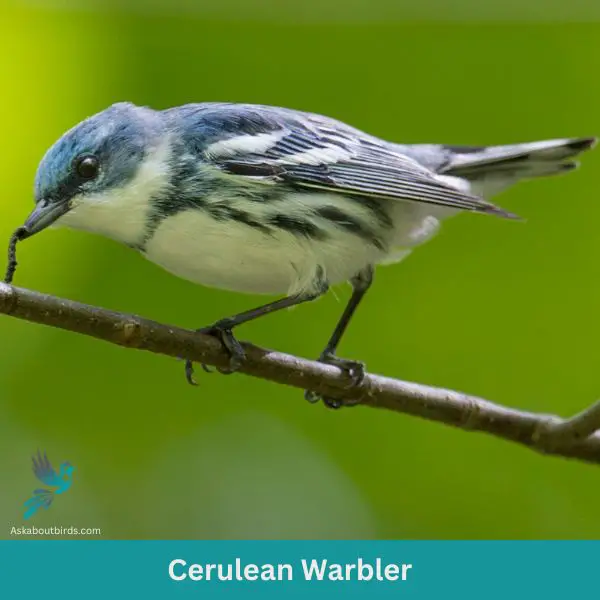
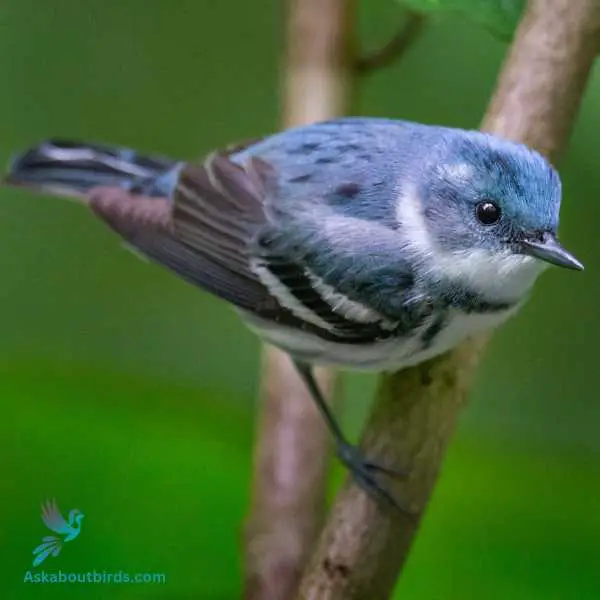
| Trait | Cerulean Warbler |
|---|---|
| Scientific Name | Setophaga cerulea |
| Length | 4.5 inches |
| Wingspan | 7.9-8.7 inches |
| Weight | 0.3-0.4 ounces |
The Cerulean Warbler is a striking songbird known for its sky-blue plumage and flitting movements in the forest canopy.
Appearance: Males boast a vibrant cerulean blue color on their upperparts, with streaked underparts, and a black necklace. Females have a more subdued bluish-green hue and lack the prominent black markings seen in males.
Diet: The diet of the Cerulean Warbler is predominantly made up of insects and spiders. They actively forage high in the treetops, gracefully maneuvering through leaves and branches.
Reproduction: Cerulean Warblers nest in the upper branches of tall deciduous trees. The female weaves a shallow cup-shaped nest and lays a clutch of 3-5 eggs.
Barn Swallow


| Feature | Measurement |
|---|---|
| Scientific Name | Hirundo rustica |
| Length | 6.5–7.5 in |
| Wingspan | 12.5–13.5 in |
| Weight | 16–22 g |
The Barn Swallow is a sleek, agile bird renowned for its graceful flight patterns and iconic forked tail, often seen darting over fields and water bodies in search of flying insects.
Appearance: Barn Swallows have deep blue, almost iridescent, upperparts and a rufous to tawny underbelly. Their distinctively forked tail and long wings give them a streamlined look. Both males and females have a similar appearance, though males often exhibit slightly brighter colors and a deeper fork in the tail.
Diet: Barn Swallows feed primarily on flying insects, which they catch in mid-air during their agile and acrobatic flights. Their diet includes flies, beetles, moths, and other small flying insects.
Reproduction: Barn Swallows are known for building their mud nests on man-made structures, particularly barns, bridges, and eaves. The nest is cup-shaped and made from mud pellets, often lined with feathers. The female lays a clutch of 4 to 6 eggs.
Belted Kingfisher

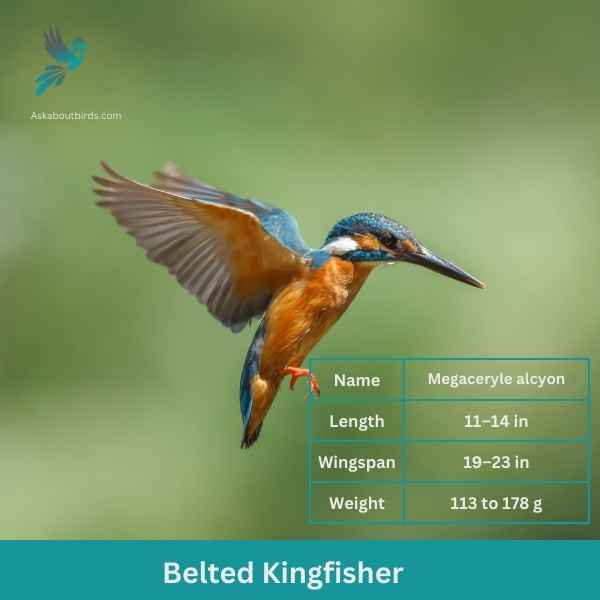
| Feature | Measurement |
|---|---|
| Scientific Name | Megaceryle alcyon |
| Length | 11–14 in |
| Wingspan | 19–23 in |
| Weight | 113 to 178 g |
The Belted Kingfisher is a distinctive and easily recognizable bird, frequently observed near water bodies, where it can be seen diving headfirst to catch prey.
Appearance: Sporting a prominent crest, the Belted Kingfisher has a slate blue-gray upper body and white underparts. Males possess a single blue band across their white chests, while females have an additional rufous band, making them one of the few bird species where females are more brightly colored than males. Their bill is long, sharp, and dagger-like.
Diet: As expert fishers, Belted Kingfishers mainly prey on small fish, but they’ll also consume crustaceans, insects, and amphibians. They’re known for their hunting tactic of hovering over water, spotting their prey, and then diving swiftly to snatch it.
Reproduction: Belted Kingfishers nest in burrows which they excavate in sandy or earthen banks, usually adjacent to water. The tunnel can be anywhere from 3 to 6 feet long, ending in a chamber. Within this chamber, the female lays a clutch of 5 to 8 white eggs.
Black-throated Blue Warbler

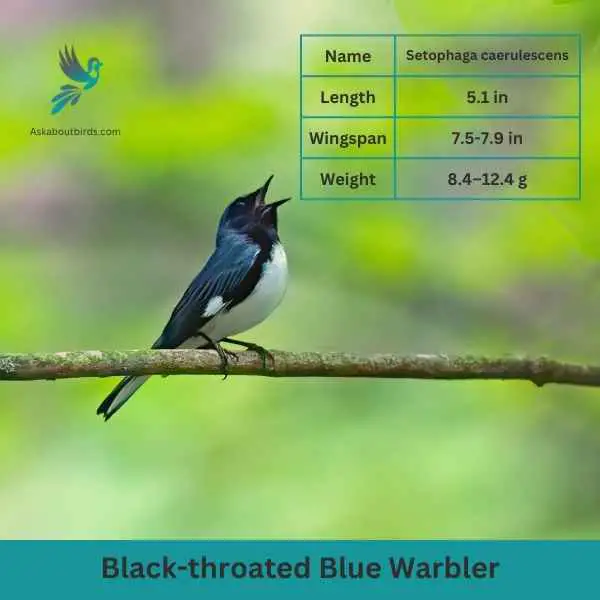
| Feature | Measurement |
|---|---|
| Scientific Name | Setophaga caerulescens |
| Length | 5.1 in |
| Wingspan | 7.5-7.9 in |
| Weight | 8.4–12.4 g |
The Black-throated Blue Warbler is a small migratory bird that breeds in the eastern United States and parts of Canada. The male Black-throated Blue Warbler displays a striking appearance with deep blue plumage on its upperparts, contrasting sharply with a black throat and a white belly. Females, on the other hand, have more muted colors, featuring grayish-olive plumage with a lighter throat.
These warblers prefer deciduous and mixed woodlands, where they forage actively for insects and spiders. They have a slender bill, which they use to extract prey from foliage and tree bark. During the breeding season, males perform courtship displays, showcasing their vibrant plumage and singing a high-pitched song to attract mates.
Black-throated Blue Warblers are known for their long-distance migration. They spend their winters in the Caribbean and Central America, where they inhabit various forested habitats. They construct cup-shaped nests in trees or shrubs, often placing them close to the ground.
Blue Grosbeak


| Feature | Measurement |
|---|---|
| Scientific Name | Passerina caerulea |
| Length | 5.5 to 7.5 in |
| Wingspan | 10 to 11 in |
| Weight | 26 to 31.5 g |
The Blue Grosbeak is a medium-sized songbird found in North and Central America. The male Blue Grosbeak displays stunning plumage with deep blue feathers on its body and head, while the female has more subdued brownish tones. Both sexes have a thick, conical bill, which gives them their name “grosbeak,” meaning large beak.
These birds prefer open habitats such as grasslands, brushy areas, and woodland edges. Blue Grosbeaks are known for their melodious songs, which consist of a series of rich and varied notes. They primarily feed on seeds and insects, using their strong beaks to crack open seeds and forage on the ground or in low vegetation.
Eastern Bluebird


| Feature | Measurement |
|---|---|
| Scientific Name | Sialia sialis |
| Length | 6.3–8.3 in |
| Wingspan | 9.8–12.6 in |
| Weight | 27–34 g |
The Eastern Bluebird (Sialia sialis) is a small thrush found in open woodlands, farmlands, and orchards, and is recognized for its vibrant blue and red coloration. Male Eastern Bluebirds are dazzling with bright blue upperparts and a rusty or brick-red throat and breast, while females, though less colorful, still offer a similar pattern. The bird is native to North America and is commonly seen east of the Rockies, from Canada to the Gulf States and southeastern Arizona to Nicaragua.
Eastern Bluebirds feed on insects, wild fruit and berries. They have a gentle nature and are often seen perched alone or in small groups in the open, scanning the ground for prey. They are cavity nesters and will use old woodpecker holes or birdhouses if they are the right size.
Where to Spot Indiana’s Blue Birds
Indiana is a birdwatcher’s paradise, especially for those keen on spotting birds with blue plumage. Here are some of the top locations in the state known for their bird diversity:
- Indiana Dunes State Park: This park, located on the southern shore of Lake Michigan, is home to over 350 bird species, including several with blue plumage. The diverse habitats—from sandy beaches to wetlands and forests – attract a wide variety of birds throughout the year.
- Goose Pond Fish and Wildlife Area: Located in southwestern Indiana, this 9,000-acre area is a major stopover for migratory birds and a breeding ground for many species. The mix of wetlands, grasslands, and woodlands provides a habitat for a variety of bird species, including those with blue-colored birds.
- Eagle Creek Park: One of the largest city parks in the United States, Eagle Creek Park in Indianapolis is home to a wide variety of bird species. The park’s reservoir, woodlands, and wetlands attract many species of birds, making it a popular spot for birdwatchers.
- Muscatatuck National Wildlife Refuge: Located in southeastern Indiana, this refuge is a haven for waterfowl and other bird species. Its mix of wetlands, forests, and grasslands provides a variety of habitats for birds, including several species of blue-colored birds.
- Brown County State Park: Known as the “Little Smokies” because of the area’s resemblance to the Great Smoky Mountains, Brown County State Park is the largest state park in Indiana. Its rolling hills, deep ravines, and dense forests provide habitat for a variety of bird species, including those with blue-colored birds.
| Neighboring States | Best Spots for Blue Birds |
|---|---|
| Michigan’s Blue Birds | 1. Sleeping Bear Dunes National Lakeshore 2. Pointe Mouillee State Game Area 3. Shiawassee National Wildlife Refuge |
| Ohio’s Blue Birds | 1. Magee Marsh Wildlife Area 2. Cuyahoga Valley National Park 3. Ottawa National Wildlife Refuge |
| Kentucky’s Blue Birds | 1. Mammoth Cave National Park 2. Daniel Boone National Forest 3. Bernheim Arboretum and Research Forest |
| Illinois’ Blue Birds | 1. Montrose Point Bird Sanctuary 2. Starved Rock State Park 3. Illinois Beach State Park |
FAQs on Blue Bird Species Found in Indiana
How can I attract indigo buntings to my backyard?
Indigo buntings are small birds with bright blue plumage in males and brownish plumage in females. They are primarily seed-eaters but also consume small insects. To attract these beautiful birds to your backyard, consider adding a bird feeder filled with their favorite foods such as black oil sunflower seeds, millet, and thistle. Indigo buntings also prefer habitats with scattered trees and shrubs, so planting native vegetation and maintaining a natural environment can be helpful. Additionally, providing a source of fresh water, like a bird bath, can also attract indigo buntings and other bird species. Remember to keep the bird feeders clean and regularly filled, and place them in a quiet and safe location.
What are the best bird feeders for attracting purple martins?
Purple martins are beautiful birds with dark blue or purple feathers and are known for their aerial acrobatics. They prefer to eat insects and are not typically attracted to seed bird feeders. However, they are cavity-nesting birds and are attracted to nest boxes or birdhouses. To attract purple martins, it is best to install specially designed purple martin houses or gourd-shaped nest boxes. These birdhouses often have multiple compartments to accommodate several families, as purple martins are social birds and prefer to live in colonies. Also, placing the birdhouses in open areas with scattered trees will increase the chances of attracting these blue beauties.
Why do some birds migrate south during winter?
Birds like purple martins and barn swallows migrate south during the winter months to find food and a more hospitable environment. In the winter, the availability of insects, which is the primary food source for many small birds like purple martins, decreases significantly in the northern regions. Also, the colder temperatures and harsh weather conditions make it difficult for these birds to survive. Therefore, they migrate south to warmer regions, where food is more abundant, and the weather is milder. South America, for example, is a common destination for many migratory birds from North America.
How do you distinguish a male bluebird from a female?
Male and female bluebirds can be distinguished by their coloration. The male bluebird usually has bright colors, with vibrant blue wings and head, and a bright red or orange chest. The female, on the other hand, has a more subdued coloration, with bluish-gray feathers and a lighter, often grayish, chest. Also, the male bluebird typically has brighter blue plumage compared to the female, which may have a more muted or duller blue color. Additionally, the young birds of both sexes usually resemble the female until they molt and acquire their adult plumage.
